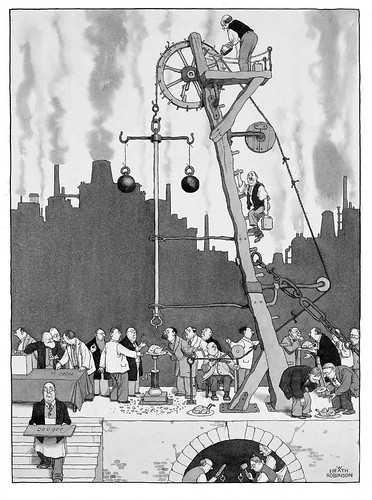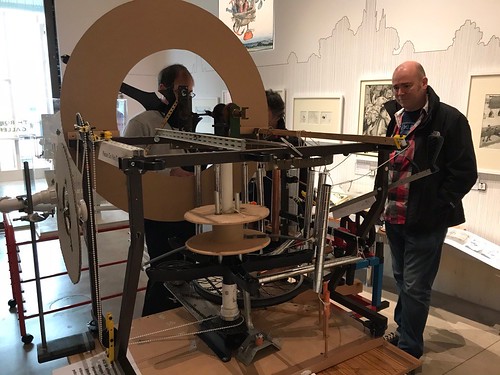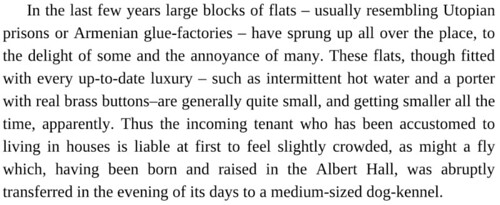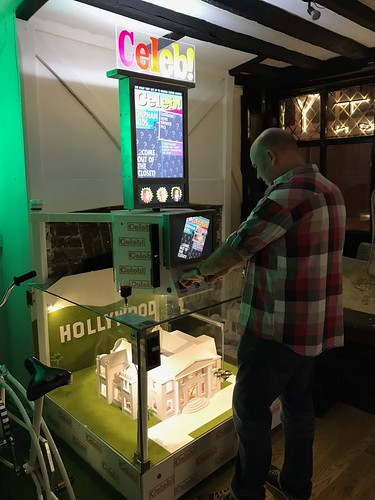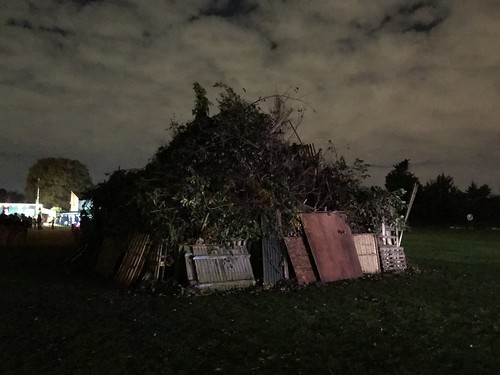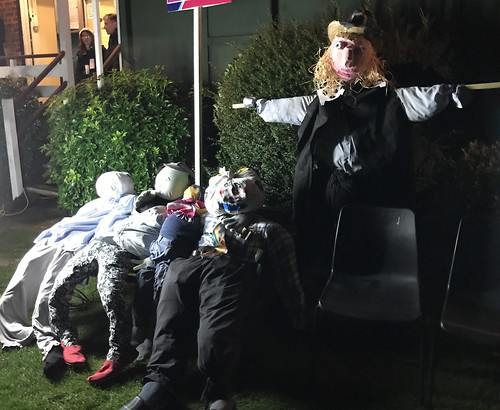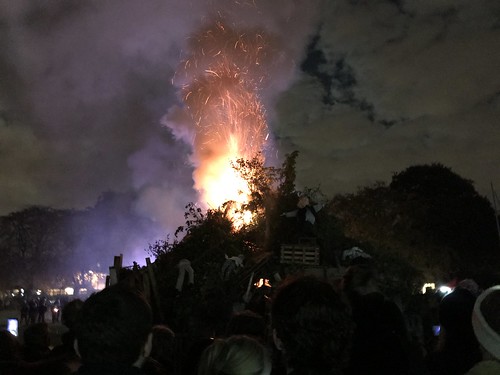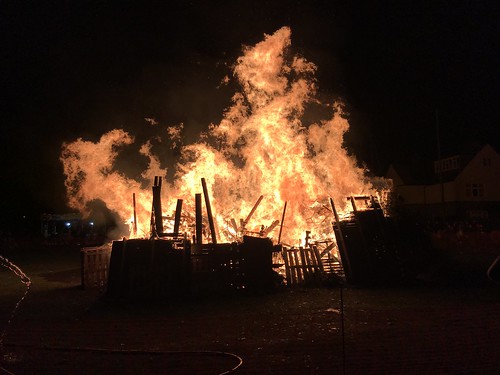It’s been a busy time here at Go Stay Work Play Live World Headquarters aboard the Lucky Nickel. For the last month I’ve been doing some quite extensive interior renovations on the boat, which has taken up 99.4% of my time and energy. I’m quite pleased with how it’s all going, and will unveil the results in a post soon. However, even the most committed renovator (and I am certainly not the most committed renovator) needs a day off every once in a while, especially when living in the same 200 square foot space one is renovating (the logistics… oy!). So I was very pleased to take up an invitation from my friend Piran who’s a regular blog reader and a Jedi Master in the field of Quirky London Things To Do. When Piran invited me out to see a mysterious, recently opened “cog and gear (kinda) museum", followed by more fantastical machines at another mystery location, I happily hung up my tape measure and blew the sawdust out of my hair to meet him at Pinner Station, not sure of what to expect but primed for a Grand Day Out.
It was a short walk from the station to a nearby park, where all was soon revealed:
Astute Go Stay Work Play Live will remember a short entry in our humble glossary on the Heath Robinson Device:
And of course I was entirely right. Heath Robinson was an illustrator and cartoonist born in 1872 in London (Finsbury Park). As I said in the glossary, he’s best know for his drawings of absurdly complicated devices designed to achieve simple tasks. They generally involve a lot of pulleys and bits of knotted string, and are surrounded by chubby bald men in overalls who tend the machines with great solemnity. There are, however, two things I didn’t realise about Heath Robinson. First, I didn’t know that aside from his best-known black-and-white cartoons, Robinson was a talented illustrator and a trained artist. And second, for some reason I sort of thought there would be actual machines, which in retrospect is a bit stupid. Because if you spend approximately one nanosecond properly contemplating any of Heath Robinson’s fantastic machines it becomes apparent they were never meant to leave the page.
The Heath Robinson Museum (great logo!) is tiny, and it’s in Pinner because Robinson lived in a house on nearby Moss Lane. And, despite my assertion that it’s not really possible to build any of his devices, there is actually a fairly impressive Heath Robinson Device on display at the museum.
This device not only cut the ribbon for the official opening of the museum in 2016 (eventually, with a guillotine-like blade on the right) it also moved the hands of a large clock and (sort of) played the Harry Potter theme tune. Or at least that was the idea. As anyone who has played Mousetrap will know, you almost always need a helping hand to get things moving somewhere along the way. One of the volunteers at the museum demonstrated the machine for us, and had to employ a few judicious nudges to keep things moving, as was the case during the official Ribbon Cutting Ceremony, depicted here.
But back to Heath Robinson. The museum is small, and displays examples of Heath Robinson’s work on the walls of one room, arranged in chronological order working through his time as an illustrator of children’s books and moving on to his very popular First World War cartoons. These mostly depict the Germans employing dastardly but absurd means of attack, and illustrate the sort of gentle satire that typifies Heath Robinson’s work. As Robert Endeacott said, "He took a stand against war by taking the piss out of Germany's horrendous war machinery"
It was during WWI that Robinson started drawing the outlandish machines that would literally make his name an entry in the dictionary. Generally poking fun at modern living, his plans for a wart removing chair, pancake flipping machine and potato peeler led on to the first in a series of “How To” books, entitled “How to Live in a Flat”. As more and more people began moving into less and less space, Robinson (as illustrator) and K. R. G. Browne (as author), presented an utterly engaging handbook for life in tiny spaces. No wonder then, that as a tiny-space-dweller myself, I snapped up my very own copy in the museum gift shop and devoured most of it on the tube ride home later that night.
After a thorough examination of the permanent collection, a spin through the temporary exhibit about illustrations for the children’s classic “The Water Babies”, and a polite ransacking of the gift shop, Piran and I retired to a nearby cafe for lunch before the long trek into the centre of town for Grand Day Out, Part Two. In fact, it turned out the Part Two was a time-sensitive event, so Piran deftly directed us through an impromptu interval at Somerset House that involved an engaging video installation, and then through a very large exhibit over many many floors of an empty building on The Strand that would take a whole other blog to talk about, so let’s skip lightly over that, pausing briefly for a nice bowl of noodles, and fast forward to the next instalment of fantastic machines.
Astute Go Stay Work Play Live Readers will remember I once visited a tiny seaside town called Southwold and encountered the fantastic Under the Pier show of wacky coin-operated machines. Novelty Automation is the London outpost of the Southwold show. Unlike the usual coin-operated arcade machine like the claw-grabber, novelty automation machines have their mechanical tongues planted firmly in their greasy little cheeks, which made this visit a perfect companion to the Heath Robinson Museum, both being sort off-beat but warm-hearted mechanical offerings. Sometimes clunky, always home-made, and an utterly engaging antidote to our current slick digital existences
The Novelty Automation arcade is open every day, but only opens in the evenings once a month, so timing for the visit was crucial. (In the evening events they serve beer!) We arrived not long after opening and invested in a couple of drinks and a handful of tokens and then hit the machines.
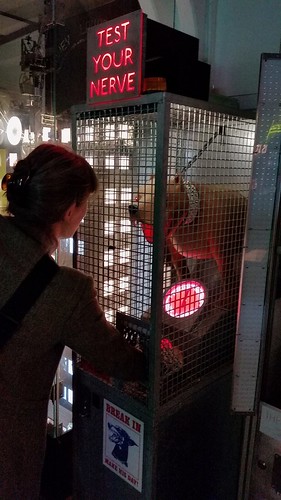
This one required you to hold onto the handle for as long as possible while the vicious dog snorts and pants and dribbles spit on your hand. It's more fun than it sounds like, really.
It was a short walk from the station to a nearby park, where all was soon revealed:
I think I may have done an involuntary “happy clap hands” sort of gesture when I saw this sign.
"Heath Robinson Device = Rube Goldberg device. An absurdly complicated and overdesigned machine to achieve a simple result, named after the British cartoonist. I imagine these to involve lots of old boots on the end of levers knocking over buckets of water... that kind of thing. And I love that they have a whole different guy for that over here. (Except that I keep mistaking myself and saying "Heath Ledger Device" which is not right at all.)”
And of course I was entirely right. Heath Robinson was an illustrator and cartoonist born in 1872 in London (Finsbury Park). As I said in the glossary, he’s best know for his drawings of absurdly complicated devices designed to achieve simple tasks. They generally involve a lot of pulleys and bits of knotted string, and are surrounded by chubby bald men in overalls who tend the machines with great solemnity. There are, however, two things I didn’t realise about Heath Robinson. First, I didn’t know that aside from his best-known black-and-white cartoons, Robinson was a talented illustrator and a trained artist. And second, for some reason I sort of thought there would be actual machines, which in retrospect is a bit stupid. Because if you spend approximately one nanosecond properly contemplating any of Heath Robinson’s fantastic machines it becomes apparent they were never meant to leave the page.
Not entirely practical Tooth Testing Machine. Ingenious, overly complicated and makeshift - the hallmarks of a Heath Robinson Device
Piran contemplating the Ribbon Cutting Machine, which definitely fulfills all three of my above criteria, and was built by members of the Heath Robinson Club at St. Helen’s Girls School. (Why did my school not have a Heath Robinson Club? Come to think of it, why doesn't every school have a Heath Robinson Club? Imagine how much mayhem could be avoided if kids spent more of their time devising ways of making a cup of tea using a water balloon, a clothes peg, an empty yogurt pot, 50 popsicle sticks, a rubber band and a half mile of knotted string.)
But back to Heath Robinson. The museum is small, and displays examples of Heath Robinson’s work on the walls of one room, arranged in chronological order working through his time as an illustrator of children’s books and moving on to his very popular First World War cartoons. These mostly depict the Germans employing dastardly but absurd means of attack, and illustrate the sort of gentle satire that typifies Heath Robinson’s work. As Robert Endeacott said, "He took a stand against war by taking the piss out of Germany's horrendous war machinery"
"Huns Using Laughing Gas to Disable British Troops before an Attack"
A sample of Browne’s sparkling prose.
Robinson’s combination Dining Room Bedroom, the Dibedroom. Perhaps I should consider this handy device while I’m doing renovations! (Actually, this is not so crazy...)
Oooooohhhh… this is going to be good!
The Novelty Automation arcade is open every day, but only opens in the evenings once a month, so timing for the visit was crucial. (In the evening events they serve beer!) We arrived not long after opening and invested in a couple of drinks and a handful of tokens and then hit the machines.
Here's me having a mini vacation, which involved sitting in an armchair while a video screen in front of me displayed a fast-forwarded trip through an airport, flight, hair-raising hotel transfer, 5 seconds of beach time and then the reverse journey, while the chair bumped and rocked along with the video.
Fantastically, most of the machines there were invented and built by one guy, who was there in the shop that night. Tim Hunkin is an engineer and cartoonist who's probably best known for drawing a long-running series in the Observer called "The Rudiments of Wisdom". It wasn't until I started looking into Tim Hunkin to write this post that I realised how perfect the link was between our afternoon trip to see classic cartoons of fantastic machines and the evening visit to see fantastic machines made manifest by a cartooning engineer. Well played, Piran!
Many of Tim Hunkin's machine's had a familiarly wry bit of social commentary served up alongside the fun. For instance, "Pet or Meat" depicts a tiny papier mache family and a little lamb, and a spinning needle determines whether the lambs is... well you get the idea. And appropriately for London, there was a money-laundering game involving high-rise real estate.
Piran played one that had him flying a "drone" camera around a model mansion snapping candid pics of celebrities that then appeared on a video tabloid front page. (The drone actually reminded me of the old Verti-bird toys from the 70s!)
Along with the wry social commentary, there were some games that were just fun, and almost all had an unexpected twist.

This one required you to hold onto the handle for as long as possible while the vicious dog snorts and pants and dribbles spit on your hand. It's more fun than it sounds like, really.
One of the more clever machines was called i-Zombie. After placing your phone in the designated spot on the machine, you're confronted with a never-ended parade of tiny phone zombie characters endlessly advancing towards you (very clever use of the classic "Pepper's Ghost" effect). Handles allow you to move your mechanical avatar back and forth to avoid them, but eventually they speed up too much and run you over. Once you're run over and the game is done you reach down to recover your phone only to discover it's gone! I was seriously taken in by this, genuinely thinking someone had nicked my phone while I'd been totally engaged in dodging plastic zombies. Then the machine informed me I'd been judged to be an i-Zombie and it had confiscated my phone for three hours! It was just the kind of unexpected twist that typified the machines at Novelty Animation. And equally typically, the machine gave me an out and produced my phone after I'd admitted to my addiction.
I could go on and on - the photo booth whose seat lurched unexpectedly as the shot was taken to capture your expression of shock, the personal nuclear reactor that dispensed a little boiled sweet as a prize for successfully containing all the spent fuel in the reactor, the Cycle Pong game that made you ride an exercise bike forwards and backwards to move your pong paddle up and down on the screen. I was complete rubbish at this, though I did get pretty good at safely storing the spent nuclear fuel, (which I think is a far more important skill, plus I got a candy.)
By the time we'd had a couple of drinks and tried all the machines we were some of the last people to leave the shop. I was utterly charmed by the place, and though it had been long, the whole experience really had been a Grand Day Out which is actually very appropriate, since Wallace and Gromit certainly belong in Endearing and Eccentric Inventor's Club, alongside Heath Robinson and Tim Hunkin. All that, and we still had time for a quick pint. Perfect.


